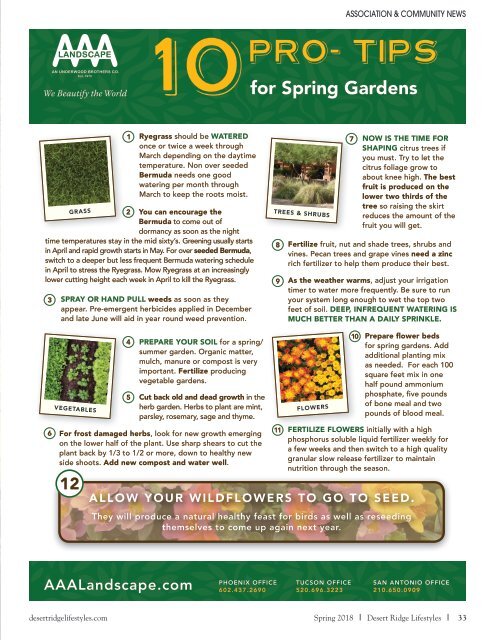Spring 2018
Spring 2018
Spring 2018
Create successful ePaper yourself
Turn your PDF publications into a flip-book with our unique Google optimized e-Paper software.
ASSOCIATION & COMMUNITY NEWS<br />
10<br />
PRO- TIPS<br />
for <strong>Spring</strong> Gardens<br />
Ryegrass should be WATERED<br />
once or twice a week through<br />
March depending on the daytime<br />
temperature. Non over seeded<br />
Bermuda needs one good<br />
watering per month through<br />
March to keep the roots moist.<br />
You can encourage the<br />
Bermuda to come out of<br />
dormancy as soon as the night<br />
time temperatures stay in the mid sixty’s. Greening usually starts<br />
in April and rapid growth starts in May. For over seeded Bermuda,<br />
switch to a deeper but less frequent Bermuda watering schedule<br />
in April to stress the Ryegrass. Mow Ryegrass at an increasingly<br />
lower cutting height each week in April to kill the Ryegrass.<br />
SPRAY OR HAND PULL weeds as soon as they<br />
appear. Pre-emergent herbicides applied in December<br />
and late June will aid in year round weed prevention.<br />
PREPARE YOUR SOIL for a spring/<br />
summer garden. Organic matter,<br />
mulch, manure or compost is very<br />
important. Fertilize producing<br />
vegetable gardens.<br />
Cut back old and dead growth in the<br />
herb garden. Herbs to plant are mint,<br />
parsley, rosemary, sage and thyme.<br />
For frost damaged herbs, look for new growth emerging<br />
on the lower half of the plant. Use sharp shears to cut the<br />
plant back by 1/3 to 1/2 or more, down to healthy new<br />
side shoots. Add new compost and water well.<br />
NOW IS THE TIME FOR<br />
SHAPING citrus trees if<br />
you must. Try to let the<br />
citrus foliage grow to<br />
about knee high. The best<br />
fruit is produced on the<br />
lower two thirds of the<br />
tree so raising the skirt<br />
reduces the amount of the<br />
fruit you will get.<br />
Fertilize fruit, nut and shade trees, shrubs and<br />
vines. Pecan trees and grape vines need a zinc<br />
rich fertilizer to help them produce their best.<br />
As the weather warms, adjust your irrigation<br />
timer to water more frequently. Be sure to run<br />
your system long enough to wet the top two<br />
feet of soil. DEEP, INFREQUENT WATERING IS<br />
MUCH BETTER THAN A DAILY SPRINKLE.<br />
Prepare flower beds<br />
for spring gardens. Add<br />
additional planting mix<br />
as needed. For each 100<br />
square feet mix in one<br />
half pound ammonium<br />
phosphate, five pounds<br />
of bone meal and two<br />
pounds of blood meal.<br />
FERTILIZE FLOWERS initially with a high<br />
phosphorus soluble liquid fertilizer weekly for<br />
a few weeks and then switch to a high quality<br />
granular slow release fertilizer to maintain<br />
nutrition through the season.<br />
ALLOW YOUR WILDFLOWERS TO GO TO SEED.<br />
They will produce a natural healthy feast for birds as well as reseeding<br />
themselves to come up again next year.<br />
PHOENIX OFFICE<br />
602.437.2690<br />
TUCSON OFFICE<br />
520.696.3223<br />
SAN ANTONIO OFFICE<br />
210.650.0909<br />
desertridgelifestyles.com<br />
<strong>Spring</strong> <strong>2018</strong> | Desert Ridge Lifestyles |<br />
33






